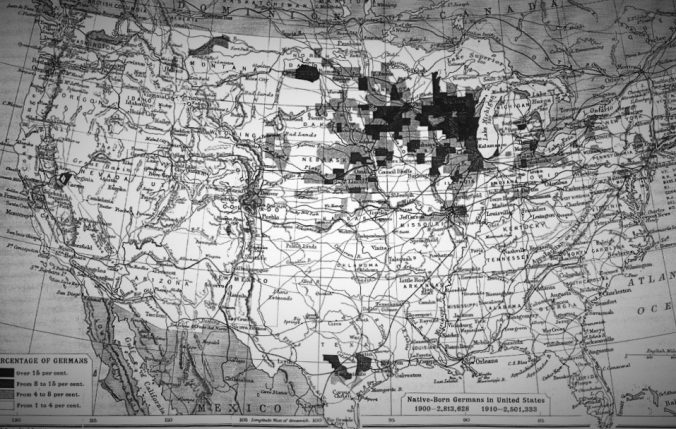Factors Influencing the Distribution of the German Pioneer Population in Minnesota
In the article, “Factors Influencing the Distribution of the German Pioneer Population in Minnesota”, published in 1945, author, Hildegard Binder Johnson, lead a study on the factors which influenced the migration and distribution of rural German settlers in specific regions throughout Minnesota during the pioneer period. What is unique about this study is that the author did not look at German migration to Minnesota as a whole, but rather examined the major settlements individually. In doing so, her aim was to invalidate common generalization regarding early rural German settlers. Additionally, she hoped that a more narrow study of individual settlements would contribute to a greater understanding of the phenomenon of immigrant distribution.
Some of the generalizations which Johnson identified were:
- The Germans were not frontiersmen who liked to settle in the wilderness (page 39).
- The German farmers instinctively selected good soil (page 39).
- Germans, like other European immigrants, preferred to settle where the landscape and climate were similar to those of their homeland (page 40).
- Germans were more frequently blacksmiths, carpenters, masons, bakers, brewers, millers, and shoemakers verses bankers, real-estate dealers, merchants, attorneys, doctors, or office clerks (page 42).
According to Johnson’s findings, the factors which did influence (or not influence) the early migration, distribution, and settlement of German pioneers varied greatly. Some examples outlined in the study included:
- Railroads: Interestingly, railroads played a minimal role in early rural German migration due to the fact that, at that time, the railroads in Minnesota were virtually non-existent (page 56).
- Rivers: The main highways of German migration were rivers. In some cases the desire to settle along navigable rivers was very strong, and it superseded the desire for timbered land. When land bordering the river was already taken, the Germans pushed inland (page 56).
- Trade interests and opportunities: A fifth of the German pioneer population that settled in towns did so because of their trade interests and opportunities and not because the towns happened to be on waterways (page 56).
- Chain migration: In some cases Johnson discovered that letters from friends and relatives were the main influence of migration.
- Notional cohesion: The factor of national cohesion was exclusively responsible for Germans settling in townships where the soil, the timber supply, and transportation facilities were no better than those of neighboring townships where they did not settle (page 57).
- Tribal character: The “tribal character” of the Germans led to distinct divisions between those from southern and southwestern Germany and those from northern Germany which also corresponded with the religious faith of the immigrants (page 57).
How does this reading apply to our study?
Although this study did not include the county in which our research is taking place, the data collected is very valuable to our study as we considering the factors surrounding German immigration as a whole. This study also provoked a number of questions I had never considered about the Apostolics in Stevens County, such as:
- Were the first Apostolics in Stevens County German? If not, what other nationalities were they? But, if so …
- What other Germans existed in Stevens County when the Apostilic Germans arrived?
- What part/s of Germany did Apostolic migrants originate? Is that origin significant in any way?
- What was the relationship with other Germans of different faiths?
- One of the largest churches in Morris is Assumption (Catholic church). What nationality start that church?
- How did the Catholic Church deal with Apostolic newcomers?
- The reading talks about the “tribal character” of Germans. Did this “character” also exist within the German Apostolics? Were they bound not only by religion but also by ethnicity?
- The reading also talks about scouts finding land for Germans. We know that there was a scout who brought the first wave of Apostolics to Stevens County.
- Who was that scout?
- Was he an independent contractor or did he work for a scouting/recruiting company?
- How does that parallel to the scouts sent to MX for present labor needs?
- The migration of the Apostolics to Stevens County occurred several years after the initial migration of German pioneers. According to this study the major part of the German migration into Minnesota would have ended by the time the Apostolics arrived, however within Stevens County the increase in German migrants had just begun. What are the past and current ratios of Apostolics in Stevens County? Has this ratio increased over time?
- What have been the primary push/pull factors bringing Apostolics to Stevens County? (marriage, church building, and economy/business)
How might this reading apply to other class projects?
Although the author’s focus concentrated solely on German migration within Minnesota, her processes of investigation and overall findings can be applied to any migration and distribution of people groups. I believe the most valuable lesson I gleaned from this study is the fact that researchers should not fall into the trap of accepting migration generalizations. I was surprised to learn how varied the migration factors were from county to county. By reviewing this study, researchers will gain a better understanding of the complexities of migration factors of a single nationality which can exist within a minimal radius.
_______________________________________________________________________________________________________________________________________
Johnson, Hildegard Binder. “Factors Influencing the Distribution of the German Pioneer Population in Minnesota.” Agricultural History 19, no. 1, 1945: 39-57.

You certainly made great use of that article and both the factual and the theoretical elements that the author highlighted. Indeed, you both point out the facts and then run with them as to how they might apply to your own project.
You have made full use of an article that others might have passed over due to the amount of time that has passed since the publication. Bravo.